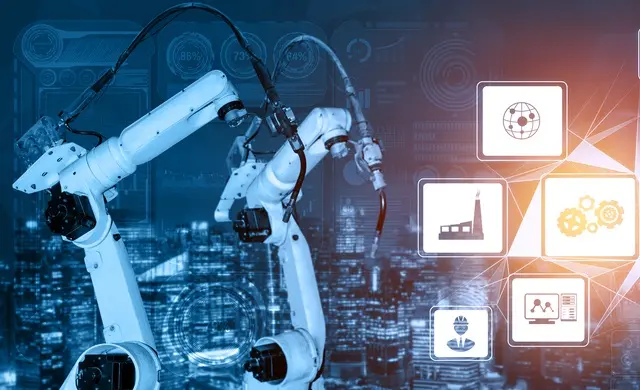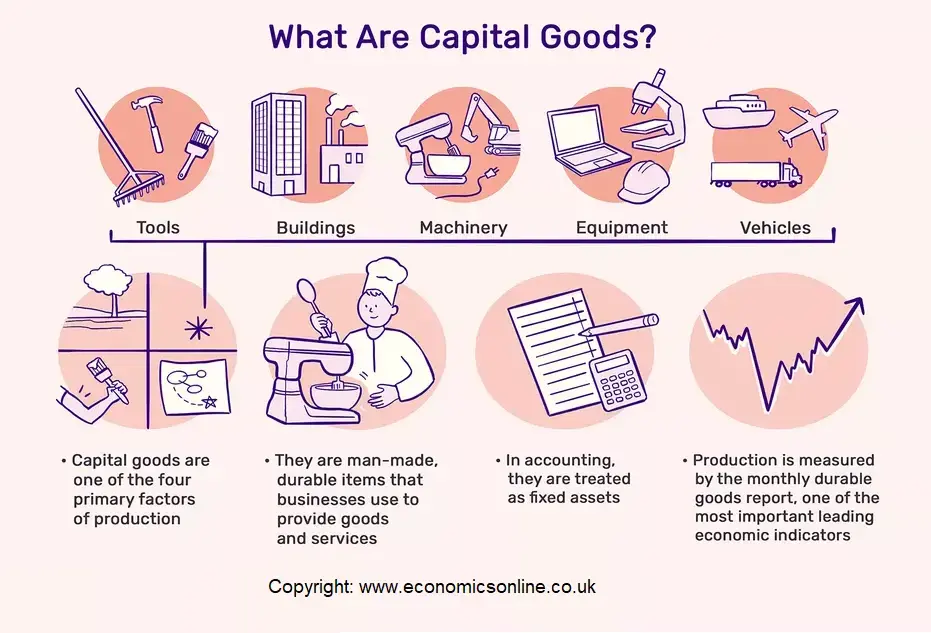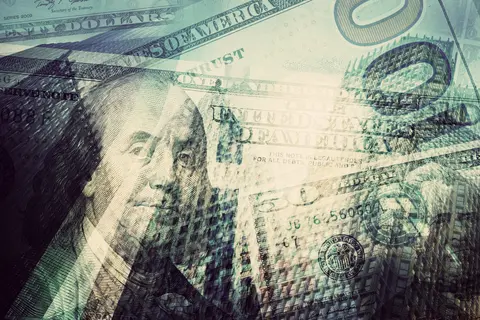
Defining Capital Goods

Definition and Examples of Capital Goods
Capital goods are durable man-made items that businesses use to produce their services and goods. They include buildings, vehicles, machinery, equipment, and tools.
In accounting, capital goods are considered fixed assets. They’re also referred to as “plant, property, and equipment.”
Capital goods comprise one of the four factors of production, meaning that businesses can’t run without them. The other three factors of production are:
- Natural resources, including water, land, and oil
- Labor, including workers
- Entrepreneurship, or the drive to create new businesses
Alternate names for capital goods are durable goods, real capital, and economic capital.
How Do Capital Goods Work?
A capital good is any man-made, durable item used to do business. Unlike consumer goods, capital goods are used to produce more goods. They don’t go straight into the manufacturing of these goods–that refers to raw materials. However, capital goods are part of the process of producing other goods and services. Some examples of capital goods are machines, construction vehicles, furniture, and buildings. All of these capital goods help to drive economic work.
Capital goods innovations can create new types of manufacturing jobs and drive business growth. When new capital goods are developed, businesses require workers to learn new skills so that they can operate them. Often, these skilled workers are in high demand.
In the US, capital goods production is measured by the monthly durable goods orders report. This report covers inventory, new orders, and capital goods shipments. It’s considered one of the most important leading economic indicators.
Core capital goods, which do not include defense equipment and aircraft, are also a leading economic indicator that tells how well United States businesses are doing. When businesses order additional capital goods, that signifies that they expect production to increase. Therefore, it shows that the economy and GDP are predicted to grow.
The durable goods report is provided by the Census Bureau, which surveys companies that ship greater than $500 million in goods each year. These companies are often part of large corporations, but they also include single-unit manufacturers originating from 89 industry categories.
Notable Happenings
From the cotton gin to drones, the US has been a technological innovator in creating capital goods. Since the year 2000, Silicon Valley has been the US center of innovation.
More manufacturing jobs are created by capital goods production than other industries. These jobs are some of the most well-paid positions, and they average $70,000 each year. The success America has had as a provider of capital goods has created a comparative advantage for the country, which helped it remain the world’s largest economy until China gained that position.
New capital goods also create economic advantages, and you can see this throughout the history of manufacturing. With new inventions came the creation of new industries, which allowed businesses and economies to grow worldwide.
- Samuel Slater improved textile manufacturing in 1789, and four years later, Eli Whitney invented the cotton gin. Together, these made the US a leader in the manufacturing of clothing.
- Morse code, as well as the telegraph, were invented in 1849. Alexander Graham Bell then invented the telephone in 1877. Together, these inventions made communication faster.
- In 1880, Thomas Edison invented a safe incandescent lamp. It made urban living easier and also allowed people to work longer.
- Steamboats led to the invention of steam locomotives, which paved the way for coast-to-coast travel, commerce, and growth.
- The invention of air conditioning allowed more people to settle in hotter areas starting in 1902. It also made it easier to work through the summer months.
- The Wright Brothers invented the airplane in 1903, which led to faster travel.
- Starting in 1908, Ford’s assembly line allowed for the mass production of affordable cars. With the increased demand for expanded travel came the 1956 Interstate Highway Act, which improved shipping and also created a higher standard of suburban living.
- Robert Goddard invented the liquid propulsion rocket in 1926, giving the US an advantage in defense.
Types of Capital Goods
There are various types of goods that impact a country’s economy.
Core Capital Goods
Another leading indicator of economic growth is core capital goods, which exclude aircraft and defense equipment. Core capital goods are large orders that do not appear regularly. They tell you how much businesses use daily.
Orders and shipments are measured by the Census Department. Shipments appear in that quarter’s gross domestic product (GDP) estimate. Meanwhile, orders don’t appear until later, when the goods are both manufactured and shipped. When core capital goods orders increase, that’s a sign that the nation’s GDP is going to increase between six and 12 months later.
Capital Goods vs. Consumer Goods
The main difference between capital and consumer goods is that consumer goods aren’t used to create other goods. However, they can both be durable goods. Similar to capital goods, durable consumer goods are long-lasting and heavy-duty. They include appliances purchased by households, such as refrigerators, dryers, and cars. There are many items that can be considered both capital and consumer goods, depending on how the items are used. The US GDP also includes shipments of consumer goods, and because of this, consumer spending drives nearly 70% of GDP.
If computers are used by a business, they’re capital goods. But if they’re used by a family, they are not capital goods. The same concept applies to dishwashers, ovens, and refrigerators. If these items are meant only for commercial use, then they’re capital goods.
Commercial aircraft are considered capital goods because airlines use them to produce the service of transportation. Meanwhile, an airplane that’s used by private pilots for weekend hobbies is labeled a consumer good. But the same type of plane used for a sightseeing business would be a capital good.
Trucks and cars are other examples. Although businesses use them as capital goods, families use them as consumer goods. Buildings are consumer goods if they’re used for housing, but they’re capital goods if they’re used as a warehouse, factory, or office.
Key Takeaways
- Capital goods are durable, man-made items that are utilized by businesses to produce goods and services.
- Construction equipment, computers, buildings, vehicles, and tools are all capital goods.
- There are four leading economic factors, and capital goods are one of them.
- When there is an increase in orders and shipments of capital goods, that’s a sign that businesses expect more demand. The economy will grow as a result.

